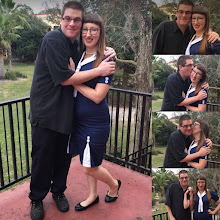As the year draws to a close, I would like to take the time to remember the following artists who passed away during 2008. There are MANY MORE I would have loved to add, but these few stay mostly within the confines of this blog (with a few exceptions).
IN MEMORIUM
Hector Zazou (ZNR et al)
Yma Sumac (queen of exotica)
Henri Chopin (master of audiopoems)
Jimmy Carl Black (formerly with the Mothers Of Invention)
Isaac Hayes (king of soul)
Michel Waisvisz (creator of the Crackle Box, Crackle Synth, Hands, etc.)
Mort Garson (Moog wizard)
Rick Wright (Pink Floyd's keyboard genius)
Rudy Ray Moore (the one and only Dolemite and a hell of a singer)
....and all other musicians, writers, and artists who passed away in '08. Thank you for your contributions to art, and though I hate to say goodbye, you deserve the rest.
Friday, November 14, 2008
Thursday, November 13, 2008
Fripp & Eno, NO PUSSYFOOTING
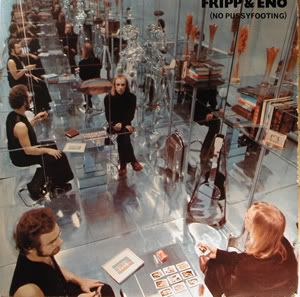
1973, Island; reissued by Discipline as a double disc; available
Original LP: 2 tracks, 39:38; double-disc Discipline reissue: 5 tracks indexed into different parts (see review), total of both discs 120:50
It's charming when you first hear something that still sounds as fresh as the day it was released. NO PUSSYFOOTING (fine, it's technically (NO PUSSYFOOTING), but the reissue varies on the spelling as well) is definitely one of those albums. When this came out, Eno was nearing the end of his time with Roxy Music and Fripp had gone on hiatus, temporarily disbanding King Crimson. Apparently Eno introduced Fripp to a unique dual Revox tape recorder setup. Similar in function to Terry Riley's time-lag accumulator, this setup allowed for layering of a bed of ever-evolving tape loops. These loops could have elements added or subtracted during the course of the composition. On top of this, Fripp solos to his heart's content, never veering into outright guitar god turf, but instead offering an emotional and very uniquely improvised tone. Hints of his Crimson work remain, but the result is distinct from that band's general sound. "The Heavenly Music Corporation", which occupied all of side one of the LP, is made up solely of this general setup. "Swastika Girls", spreading over side two and being named after a pornographic photo shoot (allegedly left behind in a studio and found by Eno!), also uses these elements. However, it adds a shrieking VCS3 synthesizer with a primitive digital sequencer as additional sound sources. The result is two wonderful extremes; "The Heavenly Music Corporation" is all soothing textures, while "Swastika Girls" has several abrasive (and almost proto-noise-rock, if there were such a thing) textures with hints of beauty. For the 2008 reissue (allegedly limited edition), Discipline has outdone themselves. Considering Fripp runs Discipline, this should be no surprise, but the deluxe reissue is amazing! NO PUSSYFOOTING has never sounded clearer, and the album will sound new even to old fans of it. However, this time, the bonus tracks are more than worth the fair price! Disc one contains the original album plus "The Heavenly Music Corporation"..... RECORDED BACKWARDS. The effect is truly otherworldly, and oddly enough it flows perfectly with the album proper. Disc two has another version of "The Heavenly...", but played at half the speed. This turns what was a beautifully soothing song into a deep droning mass of throbbing basslines and mysterious echoes. Oddly enough, it could pass for SunnO))) or Earth at this speed. This disc concludes with "Swastika Girls" given the reverse treatment. In this case, it's interesting to note how similar it sounds forward and backward, but a couple of listens will bring out the differences. As a strange bonus, all tracks are newly indexed so that you can skip ahead to your favorite segment. Thus, on disc one, tracks one through five are "The Heavenly Music Corporation", six through seven are "Swastika Girls", and eight through twelve are the reversed "Heavenly"; disc two has the slowed-down "Heavenly" occupying tracks one to five, and the reversed "Swastika Girls" on tracks six and seven. For those familiar with NO PUSSYFOOTING, the reissue is still highly recommended, as the alternate versions truly do make an interesting and vital addition. If you haven't heard it before, be ready; you'll never forget the first time you heard it, and even with the advancement of technology and Fripp and Eno's further collaborations, you'll never hear anything QUITE like it again. Needless to say, essential.
Friday, October 10, 2008
Albrecht/d. and Throbbing Gristle, a bunch of tapes
Titles are 12 AND 18 JULY 1976, 23 JULY 1976, and 30 JULY 1976 (at least two are also known as MUSIC FROM THE DEATH FACTORY). All are cassette-only releases, and each is approximattely an hour long.
So where to begin with these cassettes? Well, if you're here, you're probably already familiar with Throbbing Gristle. If not, know that they coined the term "industrial music", and that the members all went on to various other endeavors after their brief but influential existence (Coil, Psychic TV, Chris and Cosey, CTI, etc.). Albrecht/d. was (still is to the best of my knowledge) an artist and musician associated with the Fluxus movement. Everything from tribal percussion trances to electronic drones has appeared under his name; both ENDLESS MUSIC and the live album with Joseph Beuys come very highly recommended.
As for the Gristle collaborative tapes, they're about what you'd expect. Each one has approximately 30 minutes of music per side, and each side sounds like an extended jam session. This is NOT a problem at all! Synth whines are accompanied by ethnic-sounding percussion, and deep bass drones are pierced by shrill violin runs. It's a very trance-inducing experience, and it's not nearly as painful as Throbbing Gristle's SECOND ANNUAL REPORT or D.O.A. can be. I'm not 100% sure what the circumstances surrounding these recordings were, but two of the tapes are supposedly live recordings, and it's been claimed that Albrecht/d. only recorded MUSIC FROM THE DEATH FACTORY without contributing any musical input (it's also claimed he did indeed contribute drumming). All three tapes are allegedly still available through Reflection Press (http://wikihost.org/wikis/sturclub//wiki/contact for info and address), and all three are essential parts of the Throbbing Gristle story, as well as being important evidence of the influence that Fluxus, Dada, and similar movements had on early industrial.
So where to begin with these cassettes? Well, if you're here, you're probably already familiar with Throbbing Gristle. If not, know that they coined the term "industrial music", and that the members all went on to various other endeavors after their brief but influential existence (Coil, Psychic TV, Chris and Cosey, CTI, etc.). Albrecht/d. was (still is to the best of my knowledge) an artist and musician associated with the Fluxus movement. Everything from tribal percussion trances to electronic drones has appeared under his name; both ENDLESS MUSIC and the live album with Joseph Beuys come very highly recommended.
As for the Gristle collaborative tapes, they're about what you'd expect. Each one has approximately 30 minutes of music per side, and each side sounds like an extended jam session. This is NOT a problem at all! Synth whines are accompanied by ethnic-sounding percussion, and deep bass drones are pierced by shrill violin runs. It's a very trance-inducing experience, and it's not nearly as painful as Throbbing Gristle's SECOND ANNUAL REPORT or D.O.A. can be. I'm not 100% sure what the circumstances surrounding these recordings were, but two of the tapes are supposedly live recordings, and it's been claimed that Albrecht/d. only recorded MUSIC FROM THE DEATH FACTORY without contributing any musical input (it's also claimed he did indeed contribute drumming). All three tapes are allegedly still available through Reflection Press (http://wikihost.org/wikis/sturclub//wiki/contact for info and address), and all three are essential parts of the Throbbing Gristle story, as well as being important evidence of the influence that Fluxus, Dada, and similar movements had on early industrial.
Saturday, August 9, 2008
Philippe Besombes, LIBRA and CESI EST CELA

Pôle, 1974; reissued by MIO with bonus material; out of print, but the CD is fairly easy to find
MIO version: 21 tracks, 75:44
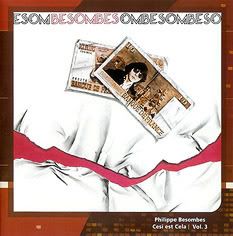
Divox, 1979; reissued by MIO with bonus material; out of print, but the CD is fairly easy to find
MIO version: 10 tracks (11 technically; see review), 79:09 (with hidden track)
Ahhhh, more Pôle-related goodies! As reviewed in a previous post, Philippe Besombes was featured on the astonishing PÔLE album by Besombes-Rizet. LIBRA was another Besombes release on Pôle Records, and while it too is electronic-rock oriented, it's quite a different beast! Originally a soundtrack for a highly experimental film without any other sound (!), LIBRA originally consisted of seventeen tracks, ranging from just under two minutes to barely over six in length. Four of the tracks were written by Besombes' other musicians, and these all stick out. As part of the whole, they're not bad, but the slightly goofy "Tis A Song" and "Boogimmick" really don't add much; "Hache 06" and "Ballade en Velo" are much better additions. Oh, but the Besombes material proper! Everything from primitive synths and organs to sitar and electric guitar shows up in these miniature masterpieces. "La Plage" opens the album and introduces a recurring synth theme (this IS a soundtrackk, remember), surrounded by odd female vocals. "Raggacountry" is a startling synth-and-sitar duet, while "Ceremonie" relies on heavy organ for an unearthly atmosphere. The album alone is a true work of art, but the bonus tracks are very tasty indeed. "Chocolate Cream" and "Tamota Pie Pie" would fit in perfectly with LIBRA proper, "Orgue Hache 06" is seventeen seconds of a single organ chord, and "Piano Prepare" is an absolutely stunning twenty-three minute piece (performed on, you guessed it, a prepared piano!). If Besombes had only recorded this, his legacy would be assured; this is even better than PÔLE!
After recording the Besombes-Rizet album, Besombes got involved with writing pieces for ballet companies (an album of library music was recorded in there as well). In 1979, he released a couple of these as CECI EST CELA ("this is that" in English) on the Divox label. Originally intended to be self-titled (the album art backs this up, and MIO previously advertised this reissue as ESOMBESOMBES!), four of its five tracks are VERY experimental pieces that foreshadow the early industrial scene while simultaneously updating and refining classic electronic techniques. Synths drone and squeal and provide all manner of sounds, accompanied by musique concrete and distorted conversations and monologues. None are as whimsical as LIBRA or PÔLE, but they do show Besombes' by-now signature sound at its peak. Track one, however, is a strange (and rather out of place) comedic disco tune entitled "Princesse Lolita", which was included at Divox's unrealistic request for a hit single. A dialogue between a helium-voiced princess and a distorted dragon, it's a fun song, but it's also very conspicuous in its dissimilarity from the surrounding material. No wonder Besombes allowed MIO to place this track in the negative space before track one! This means you have to search backwards from track one to find it; most listeners will probably never listen to it again after one go (I've only listened to it twice). The bonus material on CESI EST CELA (yes, the reissue is deliberately misspelled; why is beyond me) is divided by year. There are two tracks each from 1972, 1975, and 1976. The '72 material was recorded as a duo with Jean-Francois Dessoliers (the duo was appropriately called PJF), while the latter bonus material shows the evolution from LIBRA to PÔLE to CECI EST CELA. This is definitely Besombes at his most serious and academic, but it's still eons ahead of most contemporaries and a fascinating collection from start to finish.
Anything Besombes-oriented is a must-buy, but the recent closing of MIO can potentially hinder that. As of this writing, Wayside Music (see link on this page) is offerring all three MIO Besombes releases for six dollars each (update: CESI EST CELA is now $16, which probably means the stock is running low, so you should still get it while you can). The mastering is perfect, and the bonus material is worth the purchase alone! Get them now so you don't regret it later!
P.S. While much harder to find, his library music LP LA GUERRE DES ANIMAUX is equally amazing, as are his contributions to the CITY AND INDUSTRY LP.
Saturday, August 2, 2008
Birgé-Gorgé-Shiroc, DÉFENSE DE/LA NUIT DU PHOQUE/JUNE SESSIONS
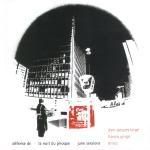
Grrr, 1975; reissued by MIO; out of print, but fairly easy to find
MIO edition: CD has 8 tracks, 73:54; DVD has 11 additional audio tracks plus a 42 minute movie, totalling roughly 6 hours (!)
This is the most formidable recording I have yet to review, but here goes anyway. Contained herein is every recording by Jean-Jacques Birgé, Francis Gorgé, and Shiroc. The former two went on to form the equally incredible Un Drame Musical Instantané with Bernard Vitet*, whereas Shiroc never recorded again after this. The first four tracks were the original LP, and when combined with the title they form a political message (I'll let you translate it yourself; wouldn't want to spoil it!). The music is..... well, it's unique, for one. Imagine a cross between the most out-there Sun Ra material, early AMM, a dash of Faust, and some of that French experimental flair. Then imagine a combination of those elements completely devoid of influences. That's fairly close to what you'll find on here! Shiroc's drumming varies from motorik pulses to free-jazz bashing, but is always tasteful and properly mixed with the other instruments. Birgé and Gorgé play an insanely wide variety of instruments; it's so varied, in fact, that a song-by-song instrument list is included! Electric guitar, synths, electric pianos, electric organs, tapes, alto and tenor sax (provided by Antoine Duvernet on two tracks), pipe organ, castanets, stylophones.... get the picture? That's also maybe a quarter of the entire list! Oddly enough, you can usually tell exactly what instrument is providing what sound, and the formlessness of the tracks works to their constantly evolving advantage. The bonus tracks are all leftovers from the album proper. Two of them were replaced with tracks featuring Shiroc, and the other two are alternate takes of "Pourrait Etre Brutal". Unlike most outtakes, these tracks are every bit as great as the album proper. The CD alone is an absolutely unique milestone of the avant-garde. The accompanying DVD, however, is the icing on the cake. Musically it features eleven more tracks, ranging from a fairly short ten minutes to a nearly forty-eight minute live track (also featuring second percussionist Gilles Rollet)! Shiroc, who was on half of the eight CD tracks, is present on every song on the DVD. Some of these "June Sessions" are even better than the album proper, and all of them would have made fine releases on their own. The experimental film "La Nuit Du Phoque" ("Night Of The Seal"), created in 1974 by Birgé and the late Bernard Mollerat, is also a very welcome addition. It's a comedic and surreal piece of art, featuring everything from a clown (I think) singing about "The Militant's Ballet" with a choreographed group of revolutionaries to Sir Isaac Newton scaring children in the park (and ending up stabbed for his troubles) all the way to a very bizarre cabaret performance with odd free jazz backing. It's a true period piece, and the fact that it exists and has been preserved is cause for celebration. Unfortunately, as stated in other reviews, MIO has ceased to exist. That makes this difficult to find, but if you search hard enough you will locate it (hint: Wayside has it for twenty dollars at the time this was written, and Birgé himself has copies for sale alongside classic UDMI material at http://www.drame.org/3GRRR/zDisco.html). An absolute must for all avant-garde fans!
*Vitet's LA GUÊPE is very much worth a listen as well!
Sunday, June 22, 2008
Caspar Brötzmann Massaker, HOME

Thirsty Ear, 1995; available
5 tracks, 53:48
Being the son of a free jazz legend, Caspar Brötzmann has skronk in his blood. While he isn't quite as unhinged as his father (and Peter Brötzmann tends to border on the lunatic side), he certainly has a charm all his own. Caspar growls and snarls and moans, but rarely ever sings per se. His guitar/amp skills (he does tend to play both) range from crushing heaviness through shrill piercing tones, and everything in between. Bassist Eduardo Delgado Lopez (who also does the occasional vocals) and drummer Danny Arnold Lommen somehow manage to provide a solid backbone to the guitar histrionics. HOME is notable for two reasons. First, it is made up of re-recordings of older tracks (all from the first two Massaker albums BLACK AXIS and THE TRIBE). The second point of interest is that these versions are vast improvements on the somewhat formless originals, with the band performing as a much tighter and unified whole. The remake of "Massaker" in particular quite frankly destroys the original, with some of the most unhinged vocals and the best breakdown on the album (oddly enough, this occurs while Brötzmann is bellowing "BREAK.... BREAK.... DOWN!"). Functioning somewhere between krautrock, doom metal and free jazz, HOME is highly recommended to more adventurous listeners. Also recommended is KOKSOFEN, which offers a looser but somehow more disturbing program.
Labels:
avant-rock,
dark ambient,
krautrock,
prog rock,
psychedelic,
space rock
Einstürzende Neubauten, KOLLAPS
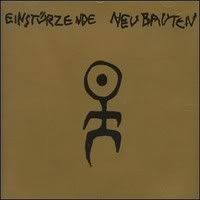
Zick-Zack, 1981; reissued by several companies over the years; available, but may be a different version than the one detailed here
13 tracks, 34:44; version with bonus track and STAHLDUBVERSIONS: 23 tracks, 56:01
Einstürzende Neubauten are pretty much a legend at this point. Taking "industrial music" to its most logical extreme, Neubauten (on here the trio of Blixa Bargeld, F.M. Einheit, and N.U. Unruh) used junk percussion, power tools, and extremely distorted guitars and bass to create a divine cacophony. KOLLAPS is widely acknowledged as their purest effort, and I agree. Very few tracks have a typical structure, or a melody for that matter. Instead you get mostly short (four minutes or less) tracks, combining the tools (no pun intended) of Neubauten's trade in bizarre and unusual forms. The main exception to length is the title track, which is over eight minutes in length and mostly revolves around a repetitive guitar mantra, punctuated by feedback and either a bass or a bass drum (it's never easy to tell what instrument is making what sound in Neubauten's music). "Tanz Debil" opens with Bargeld's impassioned yelping over some particularly nasty feedback, which then turns into a rhythmic storm of banged metal springs and whirring machine sounds. "Negativ Nein" features just the sound of water (rhythmically played water; you have to hear it to understand) and Bargeld's demented shrieks, repeating "negativ nein" in every conceivable variation. The shorter tracks like "Hirnsage" (all distorted guitar and Bargeld), "Vorm Krieg", and "Draußen ist Feindlich" are even LESS traditional in structure. This entire album STILL sounds as strange as it must have been when first released; if anything, the developments in noise and industrial since have shown just how right Neubauten got it the first time around. The version I have includes a nice bonus track called "Schieß Euch Ins Blut" that would have fit in nicely on KOLLAPS. The main bonus is the STAHLDUBVERSIONS tacked on at the end. Originally released on cassette (which curiously had the same program on both sides), these are nine instrumental dub versions of tracks from KOLLAPS. While some don't really add much ("Sado-Masodub" is basically the isolated rhythm track from "Tanz Debil"), others are truly interesting and bold experiments in combining Neubauten's approach with dub sound effects. It's a delightful addition. If you dig this, the compilation KALTE STERNE comes highly recommended; it's a collection of Neubauten's earliest recordings, and it's very much like KOLLAPS in sound and style.
Labels:
dub,
early industrial,
no wave,
noise,
noise rock,
post-punk
Sunday, June 8, 2008
NEW SOUNDS IN ELECTRONIC MUSIC
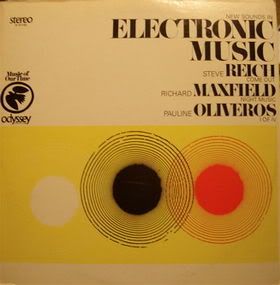
Odyssey, 1967; out of print
3 tracks, 42:27
This early electronic compilation is mostly famous due to the presence of Steve Reich's "Come Out". That track was reviewed elsewhere on this blog, so I will attempt to describe the other two tracks. Richard Maxfield (1927-1969) was a visionary composer and artist who made the best out of pre-synthesizer electronics. His "Night Music" is only featured here (for now, anyway), and is a classic little piece of primitive squeals, bleeps, and whirs. The sounds gradually take on new and strange shapes, maintaining interest throughout. Pauline Oliveros' "I Of IV" sounds considerably less primitive, and stands as an early bit of ambient minimalism. Rising and falling tones make up the bulk of this twenty-plus minute monster, accompanied by cavernous throbs and ringing high pitched whines. It definitely points towards Oliveros' later experiments in "deep listening", and still holds up incredibly well. Reich's track is available on his EARLY WORKS collection, and Oliveros' track can be found in an extended version on her ELECTRONIC WORKS compilation. That being said, only six Maxfield recordings have ever been released, and every serious electronic and/or modern composition fan owes it to themselves to hear all six. Four other Maxfield tracks are available on THE OAK OF THE GOLDEN DREAMS, which also features two extended Buchla pieces by Harold Budd. These four tracks were previously issued in 1969 by Vanguard as ELECTRONIC MUSIC.
Horrific Child, L'ETRANGE MONSIEUR WHINSTER

Eurodisc, 1976; out of print
3 tracks, 33:28
Look at that cover. Just look at it. Doesn't it just scream "incredible"? A brainchild of Jean-Pierre Massiera (also behind the equally amazing Les Maledictus Sound), Horrific Child was a complete anomaly. The "music" contained herein is three tracks of pure aural innovation. Massiera mostly assembled WHINSTER from previously recorded bits of tape, but it's all done very seamlessly. "H.I.A.", which occupied the entire B-side, has a bombastic orchestral introduction with heartbeat sound effects. It then goes into Goblin turf: all atmospheric wind sounds, footsteps, and echoing voices. After a while, some psychedelic drumming comes in, which leads right to operatic voices. This is followed by more drumming, more atmosphere, and eventually strange croaking male vocals. They're definitely cheesy, but like a good old horror film. This track features many more twists and turns during its seventeen minutes, ending on a rather sedate note. The A-side is no less impressive! "Frayeur" still features the "creepy" vocals, but this time they're accompanied by African-style drumming and chanting! Finally, "Angoisse." is all eerie synth, random percussion, and those campy-but-creepy male vocals. Apparently the lyrics are taken from Baudelaire and Lautréamont, but I don't speak good enough French to confirm this. The whole album stands up surprisingly well.; it also gains points for being incredibly unique. On the reissue of Les Maledictus Sound's sole album, there is a nine-minute excerpt from WHINSTER. Hopefully someone will have the good sense to give this a proper reissue.
UPDATE 2011: Finders Keepers had the good sense to reissue this with two bonus tracks! GET IT!
Friday, June 6, 2008
The Sperm, SHH!
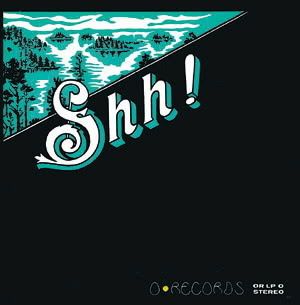
O Records, 1970; reissued on CD-R by Pekka Airaksinen; availability uncertain
LP: 4 tracks, 50:52; CD-R: 8 tracks, 69:33
What exactly WAS going on in Europe in the 70s?!?! Finland had its own psychedelic and cosmic scene during this time, as well documented on the ARCTIC HYSTERIA and PSYCHEDELIC PHINLAND compilations. Perhaps the most infamous product of said scene was the Sperm. A loose collective, the Sperm left precious little music behind, but what they DID record is amazing. Like some unholy cross between Fripp & Eno and Kluster, SHH! features four long tracks of tape-and-guitar processing. The guitar hardly ever sounds remotely like it's supposed to, instead creating avant soundscapes. "Heinäsirkat I" is a great example of this. A strange pinging/echoing sound begins the track, which over its sixteen-plus minutes manages to cover both extreme guitar sludge and buzzing insectoid sounds (appropriate, since the track's name translates to "Locusts"). Interestingly enough, a lot of the guitar sounds were made by Pekka Airaksinen (using multiple tape decks and effects) in a converted sauna! "Korvapoliklinikka Hesperia" ("The Ear Clinic Hesperia") features even more extreme treatments, and strange female vocals (probably from a tape). The true oddity is "Jazz Jazz", which indeed seems to mainly feature a saxophone on top of some feedback ambiance. "Dodekafoninen Talvisota" ends the album proper with a lengthy piece of audio art. Clangs, hums, rattles, percussion.... all add up to a twenty-minute masterpiece of avant-garde music. It may be a stretch, but some of these tracks could be considered early examples of drone doom. Sperm member Pekka Airaksinen reissued SHH! as a CD-R a while back; the CD-R has all four tracks from SHH! plus a suite of four tracks recorded in '71. The bonus tracks aren't as jarring as the SHH! material, but they make a nice addition. To the best of my knowledge, the Sperm's output consisted solely of SHH! and the follow-up EP 3RD ERECTION. All of their material is recommended, especially to fans of Fripp & Eno, Kluster, Caspar Brötzmann, and Nurse With Wound. Airaksinen also had a noteworthy solo career; his extremely rare ONE POINT MUSIC is especially worth tracking down.
*UPDATE! There is a very limited vinyl-only reissue of this available from De Stijl. Grab it while you can!
Labels:
art rock,
avant-garde,
dark ambient,
drone doom,
drone music,
early industrial,
space rock
Saturday, May 31, 2008
Intersystems, FREE PSYCHEDELIC POSTER INSIDE
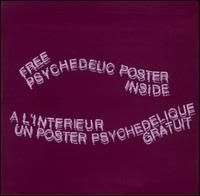
private label, 1968; reissued by Streamline; out of print
9 tracks, 50:35
Industrial music existed long before it acquired that name. This album (and many others on this blog) is proof of that. I know extremely little about this group; different sources say they were centered in France, the US, or Canada (EDIT: thanks to the comment on this entry and fact-checking, I now have pegged them as being from Ontario. Thanks, freqazoidiac!). All I know is that the members were Blake Parker , Dik Zander , John Mills-Cockell , and Michael Hayden.In a way, this is good, because the music stands just fine on its own. This is Intersystems' third album, being preceded by NUMBER ONE and PEACHY. Performed on any manner of pre-synthesizer electronics, the main elements are buzzing oscillators and strange spoken vocals. The narration falls somewhere in the vicinity of Robert Ashley's work, and concerns two lovers named Gordy and Renee. The vocals get processed at odd times, fading in and out of the mix or going from channel to channel. They also are extremely abstract, and while there is a definite concept, its exact nature is quite vague. The backing music is mostly clicks, whirs, hums, swoops, and all other sorts of primitive electronic sounds. It makes for a very interesting album, and I for one am amazed Intersystems were not included in the infamous Nurse With Wound list. Certain NWW pieces like "A New Dress" and "A Missing Sense" owe as much to Intersystems as they do Ashley. The CD reissue is hard to find but very much worth the search. Check back for reviews of the other two Intersystems albums soon!
Friday, May 30, 2008
Nihilist Spasm Band, NO RECORD

Allied Record Corporation, 1968; reissued by Cortical Foundation; availability uncertain
6 tracks, 49:58
Don't let the cheery cover fool you. Improv with attitude is what this group is all about. Formed in 1965, the Nihilist Spasm Band was an early example of noise music, as well as a fierce free improv troupe. Armed with an arsenal of mostly homemade instruments, they created some extremely aggressive music. Titles like "Destroy The Nations" give you an idea (there's also "Destroy The Nations Again"!). On these tracks, improvised raspy vocals add to the atmosphere, calling for the destruction of all nations. Whether it's serious or not is up to the listener. The other tracks are mostly instrumental, and compare favorably to the likes of AMM and Musica Elettronica Viva. However, NSB has far more energy than those groups, and creates a frantic atmosphere. The six tracks are quite lengthy and never stay in one place for long. This is a true classic from an original ensemble. Highly recommended!
Wednesday, May 28, 2008
Red Noise, SARCELLES-LOCHERES
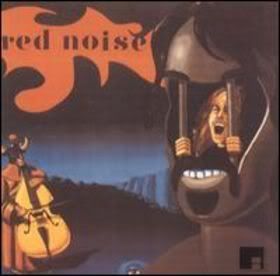
Futura, 1970; out of print*
12 tracks, 38:32
As the cover makes clear, these French eccentrics were HEAVILY influenced by Zappa. The core members on this sole Red Noise LP are Patrick Vian (who later released an excellent solo LP), Phillip Barry, Jean-Claude Cenci, and Daniel Geoffroy, plus two listed guests on percussion and organ. The music contained within is somewhat in the Zappa/Beefheart vein, but with an even MORE bizarre sense of humor, with major free jazz/improv/dada elements that put this in a class by itself. For example, the first track is "Cosmic Toilet Ditty", which is forty seconds of a guy taking a leak, followed by the toilet flushing and a voice saying "Don't forget to wash your hands, listener!" This goes right into "Caka Slow-Vertebrate Twist", which would be a pretty straightforward jazz-rock tune if not for the multiple goofy voices singing in French. Halfway through, the vocals turn into normal English singing (though the lyrics are still VERY bizarre), and the music changes to almost psychedelic folk. This is typical of the album; tracks can be all over the place musically. There are the short "Obsession Sexuelle" pieces, which are mostly screaming echoing horn sounds. The most infamous track is "Galactic Sewer Song", which has gross lyrics ("Smelling dustbins/And poo-poo compost heaps/Your puke-ridden garbage/Is excrement knee-deep") which Nurse With Wound later lifted for "The Poo-Poo Song". The music begins as a gentle strum, but rapidly becomes a jazzy freakout of gragantuan proportions, ending on a truly strange phone call. "Sarcelles C'Est L'Avenir" is also noteworthy; it sounds quite improvised, and ranges over its nineteen minutes from frantic drumming accompanied by gentle flute and guitar feedback, to an organ-led middle stretch, all the way to a weird, almost ambient dub finale, before it finally and abruptly cuts off. None of the tracks seems superfluous, and the album holds together remarkably well for all its dadaist excess. Red Noise would appeal most to fans of Zappa, and probably fans of RIO and avant-prog as well. The heavy use of skronking sax and unorthodox structures may even appeal to the post-punk/No Wave crowd (keep in mind this predated those terms). Needless to say, fellow NWW list junkies absolutely need this; it's easily one of the essentials on that list. It was reissued on CD by Futura, but is now out of print and quite difficult to find*. The effort is ABSOLUTELY worth it.
*Update! Apparently you can still order the CD direct from Futura! Check out http://futuramarge.free.fr/ and see the other (apparently available) Futura reissues as well!
Labels:
art rock,
avant-garde,
avant-rock,
prog rock,
proto-punk,
psychedelic,
space rock
Jacques Berrocal, MUSIQ MUSIK
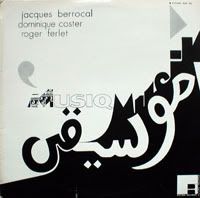
Futura, 1973; reissued by Fractal; out of print
4 tracks, 30:03
This album possibly holds the record for amount of instruments used being in disproportion to the amount of musicians (or it at least ties with a few). The trio of Berrocal (who later shortened his first name to Jac), Dominique Coster, and Roger Ferlet play no less than twenty separate instruments, ranging from common ones such as flutes and drums to the exotic shenai and "horn of Ramadan", all the way to balloons, ropes and explosives! The sounds contained on this short-but-perfect album are divided into composed pieces and improvised ones. Good luck differentiating between the two! The shorter pieces are the most intense, with screaming horns and furious percussion. Occasional human voices come in, always wordless. The explosives can be clearly heard, as can the balloons. It's free improv of a very high octane sort, with all players set on "stun". Then there's album closer "Cryptea", a ten-minute comedown after the preceding intensity. It's still not easy listening, but it's much calmer than what came before it. Not a single of these thirty minutes is wasted, and repeat listens only deepen the mysteries contained within. Any serious fan of improvisational and experimental music needs this in their collection. Unfortunately the reissue is already out of print and extremely hard to find, but make the effort anyway.
Labels:
avant-garde,
free improv,
free jazz,
jam sessions,
modern composition,
psychedelic
Wednesday, May 21, 2008
Le Grand Magic Circus et Ses Animaux Tristes, LE GRAND MECHANT COCHON ET LES TROIS PETIT GENTIL LOUPS
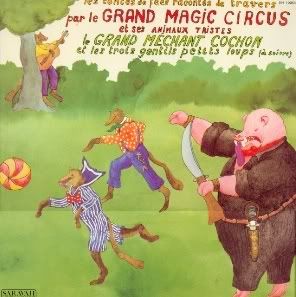
Saravah, 1974; out of print
Allegedly 9 tracks, 26:45
Continuing this blog's recent French theme (there's two more to go after this!), this may very well be the only children's record ever reviewed here. Why review a children's record? Well, this particular kid's album was included on the legendary Nurse With Wound list! Conceived by Jérôme Savary in 1965, Le Grand Magic Circus (whose full name roughly translates to the Large Magic Circus and its Sad Animals) were another example of the avant-garde thatre troupes that Steven Stapleton was so fond of. A lot more innocent than the hyper-political (and often vulgar) other troupes, Le Grand Magic Circus was indeed a large ensemble. I have no idea what anything else they recorded sounds like, but this short delight features a bunch of elements not common to a children's album. Funny and odd voices, quirky music, and a general sense of wackiness is the order of the day. As stated previously, my French is limited, but I could understand a few scattered words and phrases. The general idea seems to be a fairy tale parody told to a little girl by her grandfather. The plot involves the titular Big Mean Pig and the three small kind Wolves. The Pig's appearence is announced with a bizarre little proggy bit, interspersed with the Pig's deep bass vocals and random squeals and oinks; Grandfather has a husky but endearing voice, and he speaks a mile a minute; the Wolves tend to sing in harmony and with gusto; and the little girl has an endearingly earnest voice. A few other voices turn up, but since information on this is severely limited, I have no idea regarding the exact amount of participants. There's bits of surf rock, creepy organ dirges, folky guitar workouts, and oddly avant-garde piano bits. One of the most endearing touches is how the album ends on the exact same note it began, with the same song and everything. All of it adds up to a children's album unlike any other, easily enjoyed by even the snootiest avant-garde fan.
As an interesting footnote, both Richard and Danny Elfman had stints in Le Grand Magic Circus, as did Richard's now-ex-wife Marie-Pascale (who starred as Frenchy Hercules in Richard's FORBIDDEN ZONE). On that note, it's not hard to see where the Elfmans got a bit of influence once you hear Le Grand Magic Circus!
Heratius, GWENDOLYNE
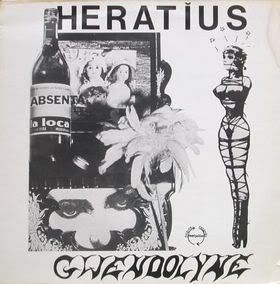
Frigico, 1978; out of print
10 tracks, 34:17
This is about as obscure as you can get. Heratius was yet another avant-garde French outfit, but rather than the electronic bent of the Pôle Records roster, they favored a sound not unlike Faust; that is, if Faust had more of an outsider tendency. Heratius was comprised of Armand Miralles, Robert Diaz, and the singularly-named Florence*. What they created is an absolutely confusing album. The cover lists only eight tracks, while the label lists all ten. "Les Pelouses" shows up in three seperate forms, possibly explaining this discrepancy. None of these sounds alike, ranging from keyboard and vocal miniatures to a bizarre six-minute rollercoaster of backwards sounds and shifting moods. Actually, hardly any of the tracks are similar to each other, being everything from folky spoken word ditties to experimental snippets. All the vocals are in French, which means of course that a lot is lost on most listeners**. For all I know the songs could have a linking theme. The vocals range from spoken word to odd male falsetto to near-operatic female vox. The music is all over the place, sometimes over the course of one song! Everything from a bluesy guitar lick to heavy organ shows up. If it seems like I'm having trouble describing this, I am. The closest comparisons are the aforementioned Faust, some Zappa, fellow French dadaists Red Noise, and a few of the more out-there avant-prog bands. This won't appeal to everybody, and I'm not 100% sure I completely enjoy it, but it definitely is unique and worth at least a couple listens.
*To the best of my knowledge. This band has EXTREMELY little information available.
**I can make out certain basic French phrases, but not much else.
Labels:
art rock,
avant-garde,
avant-rock,
krautrock,
outsider music,
prog rock,
psychedelic
Besombes-Rizet, PÔLE

Pôle, 1975; reissued by Tapioca and MIO; out of print
7 tracks, 75:44
Another stunner from Pôle Records! Actually, some claim that this is a Pôle album, and that its title is BESOMBES-RIZET. However, given that only Jean-Louis Rizet was in Pôle, and only on INSIDE THE DREAM, this probably isn't the case. Just to confuse things further, it has also claimed that Pôle was the backing band on this release! Rizet and Phillipe Besombes (who also had a healthy solo career) perform on keyboards, synths, trumpet, flute, accordion, guitar, and vocals. They are assisted by Françoise Legros on vocals, percussionist Jacky Vander Elstraete, and sax player Alain Petit. At least that's who's credited; even the reissue is scant on exact details. As for the list of keyboards used.... wow! VCS's, ARPs, Farfisas, Crumars, and more all make their appearence, lending their distinctive voices to the proceedings. Needless to say, this means the album is mostly synth-oriented, but the free-jazzy saxophone and drums definitely establish their presence. Originally a double LP, PÔLE is a surprisingly varied album. Comparisons can (and have) be made to that other giant of French experimental prog, Heldon, but Besombes-Rizet are much less ominous than Pinhas and company. The fairly straightforward synth rock of "Lundi Matin" sits comfortably next to the deep drones and oddball touches of the massive "Armature Double". The latter is the second longest track at just over eighteen minutes, with "Synth Soit-il" being just under twenty-two and "Haute Pression" clocking in at eleven minutes. These are very similar to contemporary work by Mother Mallard's Portable Masterpiece Co. and the like, but they have a distinct character. "Haute Pression" in particular sounds almost like a Klaus Schulze outtake, with an underlying pulse complimented by sharp keyboard runs and subtle variations throughout; what sets this into complete genius is the addition of motorik-influenced drums to the mix. "Synth Soit-il" follows the same path, but with the addition of drums and weird phasing effects (possibly backwards tapes). The remaining few tracks range from just under eight minutes to three and a half. "Rock a Montauban" ends up being the most out of place, sounding like a lo-fi garage rock song. The goofy vocals don't work in its favor, but it has its own oddball charms. What is most impressive is the sheer difference in mood from piece to piece, and the amazing flow of the album. This comes HIGHLY recommended, and is easily one of the best Pôle Records releases. Unlike most of their albums, this one actually got a CD reissue thanks to MIO Records; however, that label has gone under, leaving the CD out of print. Copies can still be obtained through some outlets, and I highly suggest snatching this one up on sight.
Sunday, May 18, 2008
Moolah, WOE YE DEMONS POSSESSED
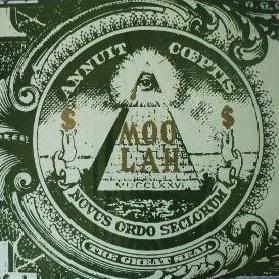
Druidstone, 1974; reissued (grey-area) by several labels; several dubious versions available, official reissue possible
6 tracks, 37:25
Moolah, the mysterious recording alias of Walter Burns and Maurice Roberson, has always been an enigma. Released on the duo's incredibly-named Druidstone in 1974, WOE YE DEMONS POSSESSED (also referenced as WOE YE DEMON POSSESSED, and with or without a comma after the WOE)is quite simply not something that should have been coming out of mid-70s New York. Just looking at the cover should tell you this is going to be an amazing listen! This absolute mindblower was allegedly recorded in a basement. While exact instrumentation isn't clear, the arsenal appears to be similar to Kluster's: keyboards (sounds like mostly organs and electric pianos), tape decks, effects, and other noisemakers, plus the addition of a rather loud drum kit. The drums aren't in every song, but on tracks like the opening "Crystal Waters", they offer a nice crashing backbeat to some cosmic keyboards and psychedelic trickery. "Mirror's" seems to be built upon a strange backwards tape loop, with some forward-playing organ improvised on top. Various guitar strums are also heard, but it's not clear if these are real-time or reversed, so dense is the production. "Terror Is Real" features some insane ramblings, proving the American origins and adding to the general ambience. All six tracks offer diverse joys, and the whole album ends much sooner than you wish. An amazing American take on krautrock, this does beg the question: Were Walter and Maurice aware of Kluster et al, or was this coincidentally similar to what was going on in Germany? Whatever the case may be, Moolah is a true treasure. Hopefully the official reissue will happen; a message made the rounds saying the reissue was in the works, bonus tracks and all, but the bootleggers affected that. I say reissue it, because I want to hear the bonus material!
UPDATE: It has come to my attention that Walter and Maurice released a second album in 1983. It was credited to Burns & Roberson or possibly Burns & Roberson Cosmic Music, but it's not clear from the cover if this is part of their name or the album's name. It seems to be called ALBUM II: SYNTHI-ACOUSTIC. I have seen a copy of this on cassette on ebay, but there is literally NO other information available on it. Any leads would be appreciated!
Pataphonie, PATAPHONIE
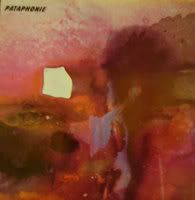
Pôle, 1975; out of print
2 tracks, 41:12
Pôle Records, in addition to the excellent LPs by Pôle the collective, released several intriguingly unique albums. The debut LP by Pataphonie is one of the best known, as well as being one of the best releases on Pôle. Technically consisting of live recordings from 1972 to 1975 (some sources say 1976, but since the album was released in 1975, this is HIGHLY doubtful), the two side-long pieces come across more as sound collages than a concert. Guitarist André Viaud, percussionist Gilles Rousseau, bassist Pierre Demouron, and keyboardist Bernard Audureau were essentially a prog-rock outfit, and that certainly does show in the music. But these live bits of sound are given a Can treatment, seamlessly meshed into long dronescapes and improvisational-sounding maelstroms. Long keyboard drones give way to percussive storms or distorted guitar freakouts. At times reminiscent of TAGO MAGO's "Aumgn" or Flying Saucer Attack's drastic Tele:Funken remix/remake, Pataphonie's debut works more as an avant-garde album than a prog one. The band probably wasn't too thrilled with the results, considering that their LE MATIN BLANC album sounds not a jot like this, but the self-titled debut is the better of the two due to its experimental nature.
Note: It may just be me, but this cover is extraordinarily similar to the covers of both Ivan T. Sanderson's "THINGS" (an excellent book, by the way!) and AMP's ASTRALMOONBEAMPROJECTIONS. While I'm sure the Sanderson comparison is coincidental, despite it coming out ten years before PATAPHONIE, could the AMP art be a sly nod?
Saturday, May 17, 2008
Maschine Nr. 9, HEADMOVIE
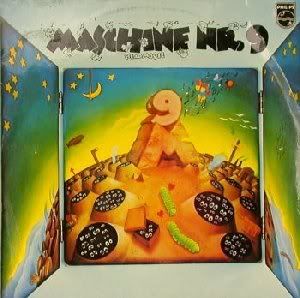
Phillips, 1973-1974 (sources vary, but these dates are the most common); out of print
Technically 2 tracks, 55:10
This is definitely one of the top five Holy Grails of the Nurse With Wound list. While technically a krautrock album, this goes far beyond anything ever labelled as such. HEADMOVIE is exactly what its title says. The only real comparison is like a cross between Miereanu's LUNA CINESE and some of the avant-theatre troupes on the list like Brühwarm or La Grand Magic Circus. Maschine Nr. 9 was a very loose collaboration. The main players were Wolf Wondratschek, Bernd Brummbär and Georg Deuter. Guests included Renate Knaup (of krautrock legends Amon Düül II) and about a dozen others. Knaup and Deuter were probably the best known contributors, with Deuter having a prolific solo career. HEADMOVIE begins with strange metallic echoes and clanging noises. After about two minutes, a narrator starts speaking in German (the predominant language on this album). The music that accompanies this audio movie includes gorgeous ambient synths, strange pulsating minimalism, repetitive folk motifs, fuzz guitar freakouts, and much MUCH more. The instrumentation seems to be mostly synth-based, but that's not entirely clear. None of the music plays for very long, being more a soundtrack to the words than anything else. Different speakers come up at different points, and some very cleverly *ahem* borrowed bits of such previous experimental efforts as "Revolution No. 9" are dropped in to spice up the weirdness. Curiously, at one point samples of the Beatles' "Good Night" are repeated; why this reasonably normal song received such attention is anyone's guess. I do wish I spoke German so I could understand the story more, but I'm fairly sure it's science fiction, most likely with a surrealist twist. "Maschine Nr. 9" is very clearly spoken several times during the record, so who knows? Perhaps that was the name of the "head movie". This is an incredibly difficult listening experience, but it is extraordinarily rewarding. An absolute treasure of the avant-garde; where is the reissue????
Friday, May 16, 2008
Cromagnon, CAVE ROCK/ORGASM

ESP'-Disk, 1969; reissued several times; available
8 tracks, 48:07
Note: Both titles have been used for this album, but not at the same time; earlier CD reissues used the title ORGASM, while the most recent CD issue uses the title CAVE ROCK. I haven't found concrete proof as to what its original name was when it was first released.
ESP'-Disk needs no introduction to most. For readers who don't know of them yet, they were a revolutionary label (still are!) that put out a lot of jazz and avant music in the 60s and 70s. From Patty Waters to Albert Ayler, Sun Ra to the Godz, ESP'-Disk covered a wide variety of amazing music. However, Cromagnon's ORGASM is definitely their weirdest offerring. Very little is known about Cromagnon; Austin Grasmere and Brian Elliot were the masterminds, but that's the only concrete fact. The "Connecticutt Tribe" assists too, and their identity is lost to history.* All Esp'-Disk offers is "There actually was a Connecticut tribe of sorts, although it consisted not of Indians but of their close Anglo friends, with several children included." Various rumors abound about Cromagnon, including that Grasmere and Elliott were former pop songwriters (which has proven to be true), that members went on to form Negativland and the Residents, that there will be a reunion tour..... The music itself needs no such embellishments. Completely out of time, CAVE ROCK/ORGASM sounds every bit that it could have been made tomorrow rather than nearly forty years ago. "Caledonia", the most famous track (and popular song to cover!), begins with fanfares over the radio, static included. It slowly builds into a mindblowing mix of bagpipes, fuzz guitar, and martial percussion, Bands like Der Blutharsch and Death In June would kill to sound like this, and the fact that such music existed in the 60s is almost unbelievable. The rest of the album is equally as mindblowing. "Ritual Feast Of The Libido" features the sounds of crackling fire, pounded tribal percussion (think slow ritual tribal rather than frenzied), and the grunts of primitive man. "Toth, Scribe 1" is a nearly eleven minute trudge that appears to be "Caledonia" slowed down drastically (in fact, that's precisely what it is). It's a frighteningly sludgy piece, possibly the first drone-doom track (that IS a stretch, but hear it and decide for yourself). Reminiscent of Neu!'s later experiments with speed manipulation, it's a definite high mark. "Genitalia" has melodious chanting and awful vocal squawks, but is too short to be annoying. The remaining tracks feature everything from incredible sound collages to distorted soloing to weird ritual chanting, with no two tracks sounding like the same band. As a whole, it doesn't sound like anything else being made at the time, or really anything else period. CAVE ROCK/ORGASM is a truly unique album, and belongs in every serious avant-rock fan's collection.
UPDATE! As of June 2009, this is back in print from ESP'-Disk! The cover is unfortunately in black and white, but it comes in a nice Digipak and has never sounded better! Get it!
*FURTHER UPDATE: Please visit this link if you want to know the story behind who was in "The Connecticutt Tribe". Long story short, it turns out Cromagnon developed out of the little-known Boss Blues. The members were Peter Bennett, Sal Salgado, Vinnie Howley, Mark Payuk, and Jimmy Bennett. The interview with the surviving members (Bennett, Salgado, Howley, and long-time friend Nelle Tresselt) is available here, courtesy ESP'-Disk: http://lounge.espdisk.com/archives/338
(Grasmere couldn't be located; Elliot, Payuk, and Jimmy Bennett are sadly departed).
Pete Shelley's Groovy Records: Sally Smmit's HANGAHAR, Free Agents' £3.33, and Shelley's SKY YEN
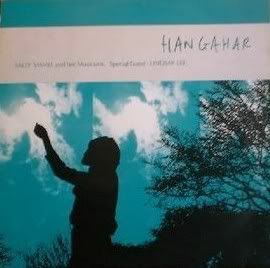
Groovy, 1980; out of print
Technically 2 tracks, 34:33

Groovy, 1980; out of print
2 tracks, 41:07
No picture available for Free Agents; trust me, I looked!
Groovy, 1980; out of print
Details uncertain; see below
Pete Shelley's Groovy Records was one of the shorter-lived labels. These three records were its only output. All three feature Shelley, which isn't surprising. What IS surprising is how much none of these records sound like the Buzzcocks. Other musicians include Sally Smmit (later to use her given name of Sally Timms in the Mekons), Eric Random (also with the Tiller Boys), Francis Cookson (also with the Tiller Boys), and Barry Adamson.
SKY YEN is Shelley's solo outing. Recorded back in 1974 (pre-Buzzcocks!) using only a "purpose-built oscillator", it's two whole sides of arty electronic sounds. Not quite high-pitched enough to be annoying, but not sedate enough to be ambient, this is pure head music. It's remarkably similar to much later ambient noise,and even reminiscent at times of early academic synth artists like Subotnick. The oscillator sounds less primitive than it should, and is far removed from similar constructs such as the Simeon. Out of the three Groovy Records releases, SKY YEN is possibly the most accessible, which IS saying a lot!
Sally Smmit and her Musicians are Smmit, Cookson, Shelley, Gerard Cookson, and Lindsey Lee. HANGAHAR (also listed as SOUNDTRACK TO HANGAHAR) is two whole sides of pure krautrock/kosmische worship. Smmit channels Damo Suzuki via Yoko Ono, and while it's never clear what's being played, the sounds all blend together into the ultimate krautrock tribute. Minimalist drumming, buzzing synths, and twisted guitar are the order of the day here. It feels like one solid piece, since side two picks up basically where side one left off. A far cry from her days in the Mekons, this is Timms at her absolute most unhinged and glorious. This would be an absolute joy to fans of far-out improv rock, as well as krautrock.
As odd as HANGAHAR is, the Free Agents' £3.33 (also referenced as simply FREE AGENTS) trumps it. At least the parts I've heard. It turns out the copy I was given was probably missing at least two tracks. Therefore, the review has been removed. However, what I HAVE heard is amazing in a Faust-meets-Rev. Dwight Frizzell kind of way. The lineup consisted of Shelley, Random, Cookson, and Adamson.
Overall, these three records were incredibly radical releases, and every one of them deserves a reissue. In a more perfect world, there would be a 2-disc set with all three! The Groovy label was a bold move, and it's a shame that more people will probably never hear its output. Luckily, Eric Random had a fairly prolific solo career. SUBLIMINAL 1980-1982 collects his weird dubby rock experiments and makes for a satisfying listen (one of these days it will be reviewed here).
Friday, May 9, 2008
Kluster, ZWEI-OSTEREI
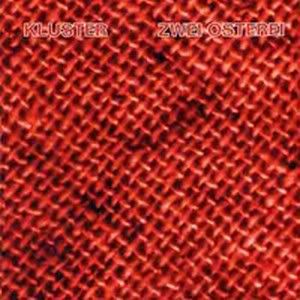
Schwann, 1971; reissued by Hypnotic and Captain Trip, each with a different bonus track; Hypnotic version out of print, Captain Trip version available but pricey
2 tracks, 44:52 (Hypnotic reissue: 3 tracks, 60:11)
Dieter Moebius and Hans-Joachim Roedelius are names familiar to most every student of ambient and krautrock. As Cluster, they pursued a deep space electronic path, approaching proto-new age and proto-ambient frequently. However, their earliest work as Kluster (a trio including Conrad Schnitzler as well) basically invented dark ambient and ambient industrial. This highly bizarre record was their second; KLOPFZEICHEN, the first, will also get reviewed here, but it is slightly more difficult to find. Schnitzler, Roedelius and Moebius didn't use synthesizers, instead relying on organs, electric guitars (normal and slide), loads of effects, and any manner of noisemaker they could find. Strangely enough, KLOPFZEICHEN and ZWEI-OSTEREI ("two - Easter egg" in English) were funded by a church! That said, there's not a whole lot in common with other church music beyond the use of organs. Track one (which was also side one) begins with a humming drone and a repeating metallic sound. This goes on for a while, and eventually guest vocalist Manfred Paethe enters the mix. His stern-sounding vocals are reciting religious text (which allegedly was one of the conditions for church funding), and while the performance gets progressively more intense, a German-speaking friend verified that the words are absolutely ridiculous. Not speaking the language is definitely a plus in THIS case! That being said, side one is an intense piece of uneasy ambience, never fully exploding into dread but constantly threatening it, and all the more impressive for that. Side two is very similar, but more free-form. Listening to this puts early industrial in its proper perspective; you could easily pass off either side as early Throbbing Gristle. Best listened to as a whole, ZWEI-OSTEREI was very much ahead of its time, and some of the ideas present wouldn't really be explored further until much later. After this album and a collaboration album with Eruption (more on them later), the band would splinter, Schnitzler going on to a solo career and Moebius and Roedelius continuting as Cluster (as well as working with Brian Eno and forming the supergroup Harmonia with Michael Rother of Neu!). Any output associated with the original trio is very much worth investigating. The two CD reissues each have different bonus tracks.The Hypnotic release features a fifteen-minute snippet(!) of a live Cluster performance from 1980. This sees the duo of Moebius and Roedelius teamed up with Joshi Farnbauer. It's a much more space rock oriented track, but it's a very nice comedown after the intensity of ZWEI-OSTEREI. I haven't heard the Captain Trip reissue, but the bonus track there is a live piece by Schnitzler's later band Eruption, which was very similar to Kluster. The Captain Trip version is pretty expensive, but you can usually find a good second-hand copy of the Hypnotic release for under $15. It comes very highly recommended no matter what.
NOTE: There is also now a three-disc box set on Water called KLUSTER 1969-1971. While it has no bonus tracks, it does have all three Kluster albums (KLOPFZEICHEN, ZWEI-OSTEREI, and ERUPTION) for a low price (around $20-$30). Needless to say, this is the Kluster set to look for. There are also some interesting archival Kluster releases from when the band was just Schnitzler and associates, Moebius and Roedelius having gone off to form Cluster(!). Entitled VULCANO and ADMIRA, these are on Important Records and are definitely worth investigating.
Monday, April 14, 2008
Third Eye Foundation, SEMTEX and GHOST
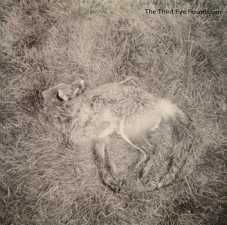
Linda's Strange Vacation, 1996; reissued by Domino; out of print
6 tracks, 48:26

Domino/Merge, 1997; out of print, but included in its entirety on disc one of COLLECTED WORKS
7 tracks, 47:39
Bristol has produced a lot of intriguing music, from the Pop Group to trip-hop to the space rock of AMP and Flying Saucer Attack. But Matt Elliott, who collaborated with those last two, probably produced the most interesting and idiosyncratic of all Bristol music. These two early releases are performed by Elliott as Third Eye Foundation. He is assisted on both by his then-girlfriend, Debbie Parsons. She later went on to perform as Foehn; indeed, one track on GHOST is credited to Foehn, though Elliott probably participated in its creation. Now, on to the records!
SEMTEX accomplishes on opening track "Sleep" what Kevin Shields had been promising for a while: drum 'n'bass/shoegazer fusion. It's an odd mix, but it works, with the blistering beats cushioning the piercing feedback-drenched guitar. The really amazing thing is how full this sounds despite being recorded on a four-track! A guitar, a Roland Workstation, some effects, Parsons' vocals, and the four-track are the only things used on these tracks, yet it sounds rich and fully produced. "Still-Life" finds Parsons' beautifully ethereal vocals accompanying another blissfully distorted guitar. The beats are slowed here, and are a cross between tribal pounding and fractured breaks. "Dreams On His Fingers" is even more ethereal, with Parsons' lovely vocals buried under layers of fuzz and crackle and gentle cymbal-heavy percussion. "Next Of Kin" is back to harsher territory, with Parsons evoking the sirens of myth while Elliott creates waves of tension. The beats here come across as tribal-influenced drum 'n' bass. The surprising "Once When I Was An Indian" is unlike any other track on SEMTEX. It is a slowly evolving slice of dark ambience that features extremely spare percussion, ringing tones that could be synth or guitar based (it's VERY hard to tell), and Parsons chanting wordless vocals. Think the Cocteau Twins gone dub and you're somewhere close to the mark. It is one of the finest examples of dark ambient/isolationism ever recorded. "Rain" ends the album with gentle cascading sounds evoking its title, fading in a fog of shimmery electronic raindrops and distortion. While it is very rare, SEMTEX is an essential album, transcending post-rock's promise to a whole new level of studio-based perfection. It also hasn't dated one bit, remaining an oddly timeless album.
An equally rare album followed SEMTEX. Entitled IN VERSION, it consisted of Elliott's remixes of AMP, Flying Saucer Attack, Hood, and Crescent. This will be reviewed once I acquire it (which, since I have yet to find it for under $50, may be a while).
(UPDATE AUGUST 2010:I finally got a great copy of IN VERSION for under $15! Review coming soon!)
Following IN VERSION, Elliott plunged further into electronics with GHOST. The guitar noise remains, but it doesn't play as central a role as it did on SEMTEX. It shares equal time (and is indeed overshadowed at times) with a sampler, and Elliott has upgraded to an eight-track. Surprisingly, GHOST has a much dirtier sound than SEMTEX, but it works in its favor. Featuring songs with titles like "Corpses As Bedmates", "Ghosts...", and "Donald Crowhurst" (whose tragic story makes for interesting reading), you can tell you're in for a much more somber listen than SEMTEX. Foehn's track, "The Star's Gone Out", is the only diversion into pure noise assault, but it's a stunning and evocative piece. It is also one of only two beatless tracks, "Donald Crowhurst" being the second. Elsewhere, "Corpses As Bedmates" features shrieking noises which sound like some Lovecraftian horror stalking its prey; these are supported by beats that remain relatively slow, then break down into fast jungle mayhem. "The Out Sound From Way In" has fractured breakbeats and a strange whistling sound, while "I've Seen The Light And It Is Dark" is centered around some kind of ceremonial trumpet (I'm guessing). Sounds reminiscent of METAL MACHINE MUSIC*, Asian vocals singing in mournful despair (both in "What To Do But Cry?"**), sonar-esque keyboard ambience ("Donald Crowhurst"), distorted glass-breaking sounds mixed with mournful strings ("Ghosts..."); these and other unusual sounds find their way into Elliott's mix, and all combine to make another stunning Third Eye Foundation album. While this is out of print, it's included on COLLECTED WORKS. That set also contains several rare singles (unfortunately with edits) and 3EF's next two albums, YOU GUYS KILL ME and LITTLE LOST SOUL. While this latter pair does move closer to normal drum 'n' bass territory, the twisted experimental innovations are still in full force. There was also a second 3EF remix compilation, with the slightly ridiculous title I POO POO ON YOUR JUJU. That features Elliott's takes on everything from experimental composer Yann Tiersen to bizarro comedian Chris Morris. Elliott's solo work is also highly recommneded, but the most recent material is VERY far removed from his 3EF days.
*While many sources say it's a direct sample from MMM, Matt himself informed me it isn't.
**Interestingly, in an e-mail from ages ago Matt told me he had no idea what the vocalist was saying, and he used the sample based solely on its mournful tone. Later he found out one of the phrases she sings is "what to do but cry?"!
EDIT: For more Third Eye Foundation and Matt Elliott, please visit the following links:
http://www.myspace.com/mattelliotandthethirdeye
http://www.myspace.com/thethirdeyefoundation
http://www.thirdeyefoundation.com (the guestbook has an early fan post by yours truly!)
Labels:
ambient,
avant-garde,
dark ambient,
dub,
musique concrete,
noise rock,
post-rock,
psychedelic,
shoegazer,
space rock
Pôle, KOTRILL and INSIDE THE DREAM

Pôle, 1975; out of print
3 tracks, 41:15
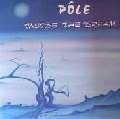
Pôle, 1975; out of print
3 tracks, 44:06
Out of the many obscurities to be found in the Nurse With Wound list, Pôle is one of the most obscure-yet-legendary. A label as well as a musical project, Pôle was established by Paul Putti in mid-70s France. The records were originally sold door to door, which is quite puzzling considering how experimental the sounds within typically were. Pôle's other signings included Mahogany Brain, Pataphonie, and other avant-garde and free improv acts. Howver, Pôle the group was perhaps the most bizarre of all the label's acts. "Group" isn't really the right word; Pôle was more of a loose collective than anything else. KOTRILL, for example, is credited to Pôle, yet Putti and Thierry Aubrun perform two tracks, while the remaining track is solely performed by Daniel Bodon! Bodon's "Osiris" is also very much the shortest track here, being a brief three and a half minutes. It's also the most accessible track, which is saying a lot, since it consists mostly of high-pitched rising-and-falling sine tones and deep bass gongs, with an occasional buzzing sound alternating between stereo channels. "Kotrill" itself is an incredible piece of avant-garde excess. Its seventeen minutes begins with the sound of tapes being wound backwards and eerie synths, evolving into a wondrous mess of musique concrete textures and backward vocals. It continues evolving and decomposing, ending on a highly percussive note surprisingly reminiscent of the end of Can's "Aumgn". This track alone explains what Nurse With Wound liked about Pôle; one could even say some of NWW's work sounds an awful lot like this piece. With "Kotrill" as the opening salvo and "Osiris" the transition, that leaves the twenty-plus minutes of "Villin-Gen" on side two. It's a very nice extended ambient piece that slowly mutates over its vast length from pure drone to more erratic expressions, while a vague rhythm is barely heard in the background. This makes for a completely engaging listen before the final beats of the rhythm fade out. This provides a nice French take on krautrock, and it even manages to blow quite a few contemporary experimentalists away!
Pôle's second album, INSIDE THE DREAM, finds Putti with a new group of collaborators and a slightly altered sound. Putti, guitarist Marc Azad, bassist Eric Dervieu, and vocalist Christian Rouch perform on the title track, which occupies all of side one. After the intensity of KOTRILL, "Inside The Dream" is surprisingly sedate. A gentle acoustic guitar is accompanied by a burbling synth-ish guitar (it really does sound more like an electronic instrument than an electric guitar) and subtle bass, with Rouch's gentle vocals evoking a pastoral image. As the song progresses, the acoustic strums remain, but more dissonant guitar starts to float above it. Towards the end, the acoustics disappear, and the freakish guitar soloing explodes, accompanied by simplistic but driving drumming. This track points forward at much later psych-folk, and even sounds a bit like Flying Saucer Attack. "Outside The Nightmare" opens side two, and is a complete departure from side one. Performed solely by Jean-Louis Rizet, "Outside The Nightmare" is fifteen minutes of analog synth space rock. The synths used are ARPs, renowned for their unique sounds, and it's anyone's guess as to how many are at work here. It sounds like stars slowly dying, which is not a bad thing at all. Also drawing comparisons to a darker take on Klaus Schulze, this track provides a nice counterpoint to "Inside The Dream"'s fairly organic sound. The album closes with "In The Maelstrom", performed by Putti, Rizet, and Pierre Chavigny. All three take up ARPs for this track, and its four and a half minutes provide a perfect end to the album. A bouncing bass pulse anchors the song, with classic retro synth stabs providing color. The whole album is another work of absolute genius.
Pôle only recorded these two albums, and the label was also sadly short-lived. All of the label's releases come highly recommended; a few have been reissued on CD, but sadly KOTRILL and INSIDE THE DREAM have yet to receive this treatment. Fans of Faust, Can, Rev. Dwight Frizzell, Nurse With Wound, et al should find these at all costs.
Wednesday, April 9, 2008
His Name Is Alive, LIVONIA and HOME IS IN YOUR HEAD
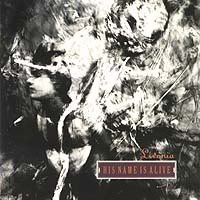
4AD, 1990; reissued by Rykodisc with bonus track "Livonia"; Rykodisc version out of print, 4AD version available as an import minus the bonus track "Livonia"
12 tracks, 35:28 (Rykodisc version 13 tracks, 39:59)
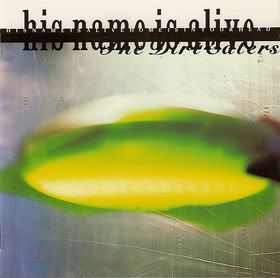
4AD, 1991; reissued by Rykodisc with additional tracks from THE DIRT EATERS EP; Rykodisc version out of print, 4AD version available as an import that includes the bonus tracks
23 tracks, 48:19 (Rykodisc and reissue versions 28 tracks, 66:28)
His Name Is Alive were always an odd prospect. Originally based in HNIA mainman (and sole constant) Warn Defever's parents' basement, the band created an incredibly atmospheric and dense sound using lo-fi methods. The music they produced has varied over the years, but on these two early releases they are in full experimental mode. LIVONIA mostly consists of demo recordings (similar to the Pixies' COME ON PILGRIM and Red House Painters' DOWN COLORFUL HILL, among other 4AD releases) remixed slightly by 4AD head Ivo Watts-Russell. The tracks veer from the chilling yet gorgeous "As We Could Ever" to the avant-rock of "Fossil" to "Reincarnation"'s bizarre sound collage and "Darkest Dreams"' dark yet comforting atmosphere. Vocalists Angie Carozzo and Karin Oliver never fail to impress, being sultry one minute, wispy the next. Defever provides appropriately varied instrumentation, mostly layering shimmering guitars and deep bass throbs. Damian Lang provides percussion on a scant three songs, Jymn Auge contributes guitar to "Fossil", and the enigmatic Tracy provides bassoon on one track. Otherwise, it's all Defever's show, which makes the results that much more impressive. Try to find the Rykodisc version; the gorgeous bonus track "Livonia" is essentially a sound collage, but it's the perfect coda to an amazing debut, and is worth the hunt.
HOME IS IN YOUR HEAD is a slightly different prospect. Carozzo is gone, but Karin Oliver remains (she also is credited with songs and guitar), along with guest vocalists Denise James and Karen Neal (on the EP tracks). The lineup is also more traditional, featuring Defever, Melissa Elliott, Damian Lang, and Jymn Auge. Oddly enough, despite the expanded lineup, the sound is starker, usually revolving around an ambient acoustic guitar. Several of the tracks are short, and a multitude are instrumental. The breathtaking "Sitting Still Moving Still Staring Outlooking" is probably the best known track, thanks to its use in JERRY MAGUIRE of all things. There is also the sing-songy "Are We Still Married?", the droning "Home Is In Your Head", short-but-sweet sound collage "Put Your Finger In Your Eye", and the eerie "Chances Are We Are Mad". All the songs run into each other, providing a seamless and fascinating listen. The overall mood is still strange, but this album definitely has a lighter tone than LIVONIA. The Rykodisc issue and the 4AD reissue both contain the excellent DIRT EATERS EP, named after Melissa Elliott's main band. The EP features five tracks: a strange but amazing cover of Rainbow's "Man On The Silver Mountain", Ivo Watts-Russell's stark and gothic remix of "Are We Still Married?" (the Brothers Quay made an amazing video for this), the distorted "Is This The Way The Tigers Do?", the folky "We Hold The Land In Great Esteem", and the gentle "The Dirt Eaters". This is the edition of HOME to get, as not a single one of these five tracks is filler.
As great as later HNIA recordings are (particularly the slightly more accessible MOUTH BY MOUTH and STARS ON ESP), LIVONIA and HOME IS IN YOUR HEAD are the essentials to understanding Defever's strange world. From there, you should progress through the catalog; there's not a bad album to be found, but the urban soul efforts SOMEDAY MY BLUES WILL COVER THE EARTH and LAST NIGHT do take some getting used to. Even the latest albums (DETROLA, XMMER, SWEET EARTH FLOWER, and FIREFLY DRAGONFLY) are worthwhile, showcasing the amazing and alluring vocals of new singer Andy FM.
Friday, April 4, 2008
R.I.P. Klaus Dinger
03/24/1946-03/20/2008
Everyone who has ever used the term "motorik" owes it to ya, buddy. Rest in peace. You won't be forgotten.
Everyone who has ever used the term "motorik" owes it to ya, buddy. Rest in peace. You won't be forgotten.
Thursday, March 6, 2008
Earth, EARTH 2
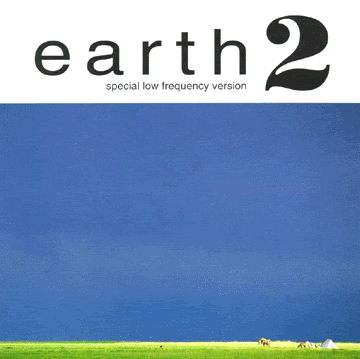
Sub Pop, 1993; available
3 tracks, 73:03
Stranger things have happened, but the sudden popularity of drone doom is still pretty odd. Seeing such bands as SunnO))) and Om being revered is nothing short of amazing, especially since the once-cult level genre is now leaking over to the hipsters. With that in mind, the recent resurgence of Earth isn't much of a surprise. SunnO))) essentially took the Earth formula of heavy drone minimalism, made it heavier, and based a career around it (and more power to them, I'm a fan!). Now that the roster of SunnO)))-owned Southern Lord records includes the revered Earth, drone doom can only get bigger. This massive disc is pretty much where it started. Earth's debut EXTRA-CAPSULAR EXTRACTION hinted at the potential for heavy minimalism, but it sounded closer to heavy grunge/Sabbath worship than pure drone. On EARTH 2, main man Dylan Carlson applied the teachings of minimalists such as Terry Riley and La Monte Young to the electric guitar and bass, creating a new genre of ambient doom metal. EARTH 2 begins with "Seven Angels", the shortest track at a comparitively miniscule fifteen minutes. "Seven Angels" actually features a discernible riff, backed by amplifier feedback and extreme distortion. Dave Harwell's bass is essentially just there to provide as heavy a backing as possible, with Carlson evoking Iommi playing at a fifth of the speed. It makes for a ever-so-slightly accessible plunge into the album. This track segues into the crushing middle track, the twenty-seven minute "Teeth Of Lions Rule The Divine". Sounding like the apocalypse, but strangely relaxing at the same time, "Teeth..." is drone upon drone, approximating the sound of a black hole. While not as heavy as SunnO))) (who named a side project after this song), it clearly was the most extreme experimentation going on in early 90s America, and its pure power and dedication to the amp is still intoxicating. Last up is the thirty-minute dirge-fest of "Like Gold And Faceted". Carlson's love of the minimalists is in full force here, for upon first listen this sounds like the same note of feedback (layered feedback at that!) held for half an hour, with the occasional percussion added by Joe Burns. A closer listen reveals there ARE changes, on a microtonal level. The end result is an impeccable combination of minimalism's micro-changes and the sheer power of a Sunn amp and a guitar. Granted, compared to the subsonic terror of today's drone doom legion, EARTH 2 sounds quaint. As a bold experiment in sound, though, it has few peers. Earth's following album PHASE 3: THRONES AND DOMINIONS has a slightly treblier tone, and it's a nice companion piece. PENTASTAR: IN THE STYLE OF DEMONS is a bland attempt at fitting the grunge mold, but it still has several good moments. The other Earth albums veer from long live jams to country-influenced post-rock heavy minimalism; all of this is well worth investigating. However, should you choose to only own the essential Earth, this is it.
Labels:
ambient,
avant-garde,
drone doom,
minimalism,
post-rock,
psychedelic,
space rock
Monday, March 3, 2008
Various artists, HOLLERIN'
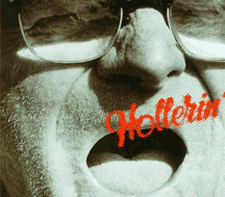
Rounder, 1983; available
24 tracks, 59:21
For years I've known of this album. I had MANY misconceptions about it. For one, I was under the impression it is just a live recording of the National Hollerin' Contest (it actually seems to be field recordings a la Alan Lomax). I also assumed it was going to be an awful recording only good for a laugh. In my defense, one of the tracks IS credited to "Dan McLamb & His Three-Legged Dog Percy". The truth is that this is an extraordinarily interesting and poignant document of an unknown American folk tradition. Hollerin' (that's the actual spelling) has its origins in the pre-mass communication days and was centered in Spivey's Corner, NC. Most people today feel they can't live without a cell phone; the farmers who created hollerin' didn't even have home phones or walkie-talkies. The style orginated as a way of communication and bonding, since hollerin' can be very loud and heard for miles. It can be divided into four basic subcategories: Distress hollers, used to announce death, accidents, emergencies, etc.; functional hollers, such as animal calls; communicative hollers, the hollerin' equivalent of "hiya, neighbor!"; and expressive hollers, which can be original or traditional songs in holler style and other purely fun hollers. Most of the tracks, especially those by Leonard Emanuel and O.B. and Dewey Jackson, share a lot in common with other unusual vocal styles such as throat singing and sacred harp. If you can picture throat singing done with high pitches rather than low pitches, you have a solid idea of what this is like. The functional hollers are as unique as each artist; no two truly sound alike. Along with animal calls, there is an example of a holler used to "mock a fox". The original expressive hollers obviously had care put into their creation, including Leonard Emanuel's touching-but-snarky "I Wish I Was Single Again". The traditional expressive hollers include "Shortnin' Bread", "What A Friend We Have In Jesus", and even versions of "Santa Claus Is Coming To Town" and "Happy Birthday To You"! Both Emanuel and H. H. Oliver present distress hollers; it's easy to see why these would draw attention. The communicative hollers have some of the most lilting passages, and the spirit of camaraderie literally pours out of the performers. For being recorded in 1975 and 1976, the sound quality is impeccable, lacking the defects which sometimes tarnish older field recordings. There are ten different performers, each with a hollerin' style all their own. Names like O.B. Jackson and Dewey Jackson (yes, they are related) are probably unknown even to serious folk scholars, but they shouldn't be. While many listeners seriously just won't be able to get into this, students of folk music and even outsider music fans need this album. It truly is one of the most amazing documents of American folk I have ever heard and it deserves to be more widely known.
Friday, February 22, 2008
Martin Davorin Jagodic, TEMPO FURIOSO & Costin Miereanu, LUNA CINESE
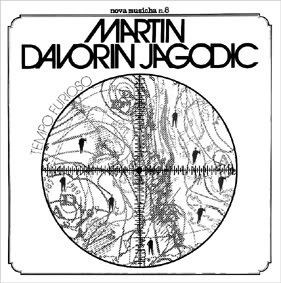
Cramps, 1975; reissued by a Japanese label; available but pricey
2 tracks, 42:03

Cramps, 1975; reissued by a Japanese label; available but pricey
2 tracks, 41:11
The Italian Cramps label was known for producing excellent albums, usually in the prog or modern composition genres. This pair of records falls into the latter category. Both consist of two long tracks (one per side), and both must have required hours of construction, but that's where the similarities end. Jagodic's work is more harsh and noisy. The two sides are indeed furious, piling sound upon sound, only to have some of the sounds drop off and be replaced. Sine waves and drones make up the background, with multiple vocals overtop. It's infinitely more listenable than it sounds, and it's a truly amazing work. Some of the ideas on here wouldn't turn up again for more than a decade. Miereanu's pieces are different, but each has its merits. Side A sounds like a science fiction broadcast given the musique concrete treatment. Female vocals make announcements about moon bases and the like over an atmospheric background. Side B is closer to minimalism, with what sounds like organ or synth tones moving at a glacial pace. It's a nice comedown after the chaotic first side. Both of these LPs come highly recommended, but the Japanese reissues are VERY expensive.
Cupol, LIKE THIS FOR AGES/KLUBA CUPOL

4AD, 1980; original single out of print, but both tracks are available on the Gilbert/Lewis compilation 8 TIME
2 tracks, 24:53
Cupol was a one-off side project by Wire's Bruce Gilbert and Graham Lewis. The two artists would later collaborate under the names B.Gilbert/G. Lewis (or Gilbert and Lewis, or any variation thereof) and Dome, but Cupol is possibly the finest example of their synth work. The A-side, "Like This For Ages", is a concise four and a half minutes of crunchy synth sounds, pained vocals, and eerie atmospheres. It sounds a lot like Throbbing Gristle attempting a dance hit minus the irony of "United", or Clock DVA combining the early and later stages of their career. I wonder if this was a club hit back in the day; it certainly could fit in well with other post-punk of the time. The B-side, "Kluba Cupol", is a completely different prospect. Beginning with sine tones, "Kluba Cupol" extends over a massive twenty and a half minutes. It's essentially an extended instrumental take on "Like This For Ages", but it's extremely different and more experimental. What sounded oddly danceable on the A-side becomes bleak and cold, putting this more in line with Current 93, Sleep Chamber, and other purveyors of ritual industrial and dark ambient. "Kluba Cupol" can even be considered the first example of isolationist music. It's odd to have one side of a record be five times as long as the other, but Cupol makes it work. As stated above, this EP is now out of print, but the Gilbert & Lewis compilation 8 TIME contains both tracks in their entirety, and is well recommended for that fact alone. The other material on 8 TIME is good, but it doesn't come close to the atmospheric dread of Cupol.
Labels:
ambient,
art rock,
avant-pop,
post-punk,
psychedelic
Sunday, February 17, 2008
AMM, AMMMUSIC 1966
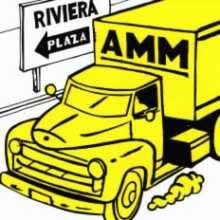
Note: This album is variously listed as either AMMMUSIC 1966 or AMMUSIC 1966; even the liners vary in spelling!
1967, Elektra; reissued by ReR; available
8 tracks, 74:26
AMM doesn't need a lot of introduction. One of the longest lived free improvisation ensembles, they have been producing boundary-pushing music for over forty years. AMMMUSIC 1966 is the debut recording by the group, and the classic lineup is in place. That lineup would be Cornelius Cardew, Lou Gare, Eddie Prevost, Keith Rowe, and Lawrence Sheaff. Cardew was already an established modern composer, and Prevost has been the only constant through the years; Rowe was a constant for an extended period but has since parted ways with AMM. The instruments listed are varied, including everything from cello and accordion to transistor radios (Cardew, Rowe, and Sheaff are all credited with the latter). The CD is indexed somewhat confusingly; there are indeed eight tracks, but technically there are only five pieces of music. Tracks one and two are both part of "Later During A Flaming Riviera Sunset", and tracks five and six both comprise "After Rapidly Circling The Plaza", while track eight is ten seconds of silence. The indexing makes sense, though; the original LP featured edited versions of "Later" and "After", and the CD allows you to listen only to the original LP's material. "Later" begins the album with a bang. Twenty-eight minutes of hardcore improv are spread over the two tracks, never comfortably sounding like any one genre. "After" is slightly over twenty-four minutes in length and similarly presents a grand look at AMM's strengths in an extended format. The other three tracks are shorter but no less intense; the nearly six minute "Ailantius Glandulosa" actually contains some of the more jarring moments on the whole album. "In The Realm Of Nothing Whatever" is a mellower piece that's just under fourteen minutes, and "What Is There In Uselessness To Cause You Distress?" is a concise three minutes. Sheer explorations of sound on each track leave the origin of individual sounds to speculation. The violin, cello, and guitar are particularly warped, so that none are easily identified. The radios provide frequent mysterious soundbites, some in English and some not. Prevost's furious percussion is about the only element that leaves no speculation. Not really rock, and not truly jazz or classical either, AMMMUSIC 1966 is still a marvelous souvenir of free improv's early days. The thick booklet alone is nearly worth the purchase. It contains the original LP notes (more like mysterious questions and declarations) and a long essay by Prevost, who recounts how audiences back then didn't know what to make of the group. It's doubtful a lot of modern audiences can get into this, but in an age where Wolf Eyes and SunnO))) are hipster icons, AMM deserves reevaluation. It's not much of a stretch to say that the first wave industrial bands (Throbbing Gristle, Clock DVA, Nurse With Wound, etc.) and the noise musicians owe a huge debt to this album. Absolutely essential!
Labels:
free improv,
free jazz,
modern composition,
musique concrete,
noise
Friday, February 15, 2008
Anal Magic & Rev. Dwight Frizzell, BEYOND THE BLACK CRACK

Cavern Custom, 1976; reissued by Paradigm; apparently available
14 tracks, 69:07
I'll get this out of the way: The title, cover, and some of the song titles on this album are VERY hard to get past. Thankfully, it isn't a juvenile series of dirty jokes, but rather a serious and amazing avant-garde treasure. Rev. Dwight Frizzell (yes, the title is official) is the mainstay on every track. I'm assuming Anal Magic was more a collective name for his projects than an actual group, since the bands listed are actually Black Crack and the Sole Survivors and Fredrik's Cosmic Spaced Out Blues Band and Orchestra. There's also a collection of five tracks collectively known as "Turtle Music", as well as a couple bonus tracks from a later Frizzell composition called "The Wandering Madness Of Basilea, The Great Mother". Most of this album seems to have been recorded live, but only the Cosmic Blues Band tracks have any audience sounds. "Black Crack and the Sole Survivors" is a massive thirteen minute slice of weirdness. Rattling percussion, random vocalisations, and strange sounds are the order of the day. The liner notes say it was recorded live on three seperate dates, and the results seem to be an audio collage of these performances. "Black Crack" is an absolute gem of experimental music. If you passed this off as a track by Faust or Nurse With Wound, nobody would question it. In fact, this track alone explains why Anal Magic was on the infamous NWW list. The following three tracks are by the Cosmic Blues Band, and were recorded live at a church chili supper. The songs have goofy titles like "Hot Fudge" and "Get It Out Of Your System", but the music itself is a heavenly slice of post-Sun Ra strangeness, punctuated by Frizzell's experimental use of an oscillator and other electronics. It's a delightful mix. The "Turtle Music" tracks were mostly recorded live on "the midget pyramid in McCoy Park, Independence, Missouri". They are mostly percussion and wind instrument jams, accompanied on "Pre-Transformation Of Turtle To Bird" by the sounds of children playing. One of the kids is heard asking Frizzell "What are you doing this for?"; his response is simply "I'm making a recording!". Throughout these tracks, various sounds from the park are heard, lending an unearthly atmosphere. The final track, "O What Joy It Is To Know You Have A Turtle Heart", is a splendid saxophone drone, recalling Terry Riley's sax playing. The bonus material begins with the aforementioned "Basilea" tracks. These are heavily electronic works, concluding with Harry Truman's speech on the atomic bomb accompanied by the sounds of a geiger counter and tape-modified voices. The final bonus track is a "1997 remix" of unused Black Crack material. While just over two minutes in length, this track (amusingly titled "How To Avoid Simultaneity") is a great capper to a unique album. The combinations of diverse avant-garde styles may be a little inaccessible, but repeated listens make this a surprisingly solid album, comparable to other outsiders of the period such as Zweistein. The bonus tracks meld seamlessly with the original LP material, and the sheer sense of adventure carried throughout is refreshingly unique. HIGHLY recommended, but good luck finding it; the 1998 repress was a limited edition of 1000, and the original LP was limited to a scant 200 copies.
Postscript: For a two-minute snippet of "Black Crack and the Sole Survivors", other reviews (not all positive), and a brief history, please check out the following link: http://www.stalk.net/paradigm/pd06.html
UPDATE! Paradigm has reissued this! Get it before it goes out of print again!
Friday, February 8, 2008
Steve Reich, EARLY WORKS
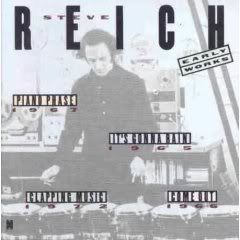
Elektra/Nonesuch, 1987; available
5 tracks, 56:26
First off, this is essential. Short of the amazing 10-CD WORKS boxset, this is the Reich everyone needs. Consisting of four pieces (one of which is divided in two parts), all composed between 1965 and 1972, this compilation showcases even amounts of minimalism and musique concrete. "Come Out" and "It's Gonna Rain" parts one and two fall into the latter category. In "Come Out", a victim of police brutality's account of his mistreatment becomes a nightmarish mass of loops, words melting into pure sound. "It's Gonna Rain" does similar things to the apocalyptic ranting of a preacher. The effect is extremely fascinating and oppressive in equal amounts. On the opposite extreme, "Piano Phase" features a gorgeous piano duet, which goes in and out of phase as the piece unfolds over twenty minutes. This is pure proto-ambient, absolutely beautiful yet requiring no listening to be felt. "Clapping Music" is exactly that. The phasing in this case comes from the claps falling out of synch. It's definitely the weakest composition on here, but it is easily forgivable surrounded by the other masterpieces. For the roots of minimalism and its ties to musique concrete and early electronic music, look no further than this disc.
Monday, January 21, 2008
Mother Mallard's Portable Masterpiece Co., 1970-1973 and LIKE A DUCK TO WATER

Earthquack, 1973; reissued by Cuneiform; available
5 tracks, 66:26

Earthquack, 1976; reissued by Cuneiform; available
7 tracks, 62:17
These two releases constitute some of the most important early electronic music. Mother Mallard's Portable Masterpiece Co. was intended to be the first all-synthesizer ensemble. I'm leaving that issue well enough alone, except to say the odds are most certainly in their favor for that claim. The main importance lies in the music presented on these two discs and their desire to bring the sounds of electronic music to the masses. The trio initially consisted of composers David Borden and Steve Drews on Moogs and electric pianist Linda Fisher. Borden was Bob Moog's guinea pig during the development of the Moog synthesizer. All you electronic fans owe this man a huge thank you, for he was an important part of making the synthesizer user-friendly. Three of the tracks on 1970-1973 were originally released as an LP in '73; the remaining two tracks saw the light of day on this reissue. Drews composed two out of the five tracks, the remaining three being Borden's creations (Oddly enough, Mother Mallard was originally intended as a sort of minimalism cover band; however, all their recordings consist of original compositions). The material never displays its age; "Cloudscape For Peggy" and "Easter" could easily be passed off as early Orb or Aphex Twin. "Train" is the only track that clocks in at under twelve minutes (at a mere seven minutes!); "Easter" is a mammoth nineteen minutes and twenty-three seconds. The timeless Moog sounds and intricate compositions are a real eye-opener. "Music" even makes use of a looped vocal sample ("music music music...."), pointing very far forward to much later techno. Despite the limited technology (Moogs were still monophonic back then), these tracks are extraordinarily intricate and warm, with far more humanity behind them than Kraftwerk or Tangerine Dream ever had. Based on the debut salvo alone, Mother Mallard should be worshipped by acolytes of the Cult Of Techno/Drum'n'Bass/Ambient/whatever electronic genre you can imagine. Yes, it's THAT good.
However, the best was just around the corner! Circa 1974, Linda Fisher parted amicably with Borden and Drews, and new electric pianist Judy Borsher stepped in. She is featured on all seven tracks of LIKE A DUCK TO WATER. Drews also takes over the bulk of the credit on this one; he has five compositions to Borden's two. The original LP consisted of Drews' "Oleo Strut" and "Waterwheel" and Borden's massive "C-A-G-E Part II". "Waterwheel" in particular is breathtaking; truly sounding like its title, this is a ten-minute piece of sheer beauty, with cascading ripples of sound and a propulsive bass pulse. "Oleo Strut" is similar, but has its own distinct identity, and is a perfect companion piece to "Waterwheel". "C-A-G-E Part II" (obviously named in tribute to John Cage) is a twenty-minute leviathan, based around the notes/pitches that make up the title. This piece is a great bit of minimalism, ranking with the best of the (unfairly) better-known minimalists' work. The remaining four tracks are very worthwhile as well; Borden's "All Set" and Drews' "Downtown" and "Theme From After The Fall" are great examples of shorter-form minimalism, and Drews' "Harpsichord Truck" makes for a pleasantly lighthearted coda to the album.
On their own, each of these albums is a classic landmark of electronic music. Together they form a whole hidden chapter in electronic music's short history. Don't let the recording dates scare you; there is absolutely nothing primitive about Mother Mallard's sound. I heartily recommend both to fans of any synth-based music, minimalism junkies, ambient connoisseurs, and adherents of the spacier realms of Krautrock/kosmische musik. Cuneiform has the full tracks "Downtown" and "Trains" to preview here, along with several of Borden's post-Mother Mallard releases (which also come highly recommended): http://www.cuneiformrecords.com/bandshtml/borden.html
Postscript: If you're hooked, there is an additional CD released by Arbiter which contains "The Continuing Story Of Counterpoint" parts one and three (including a chorus in addition to the synths) and "C-A-G-E Part III". This also comes highly recommended. Also check out http://www.mothermallard.com .
Labels:
ambient,
avant-garde,
early electronic,
minimalism,
modern composition,
space rock
Tuesday, January 15, 2008
Debris', STATIC DISPOSAL

Static Disposal, 1976; reissued by Anopheles; available
21 tracks, 76:42
The cover alone should tell you the world wasn't quite ready for Debris'. Being a post-punk band in a pre-punk world, they really had the odds against them. Sure, there were similar contemporaries like Pere Ubu and MX 80 Sound, but those bands sound tame in comparison. Imagine the Stooges jamming with Chrome with some guests from the New York No Wave scene and you have a good idea of how this sounds. Seriously deranged synths and pounding drums collide with Echo-Plexed guitar and way-out vocals, sometimes accompanied by everything from woodblocks to a circular saw. Opening track "One Way Spit" is pretty indicative; the track opens with what sounds like a madman counting down (out of beat!), followed by a guitar line straight out of FUN HOUSE. Then the synth comes in with all its bleepy-UFO glory. "Female Tracks" features female vocals reciting the definitions of "female" and "tracks" over another dadaist splurge. "Witness" is an almost jazzy spoken word number with Christian lyrics (!). As if that opening salvo wasn't strange enough, the weird factor just keeps going up on every successive track. The trio of Oliver Powers, Chuck Ivey and Johnny Gregg set out to make "the ultimate record". While that's VERY subjective, the results contained herein are indeed wonderfully refreshing. Tracks one through eleven are the album proper, which was originally untitled and put out on the band's own label. It was also supposed to serve as a demo, and was sent out to various magazines and record labels. A particularly scathing letter from EG is included in the liners. The remaining ten tracks are rehearsal recordings, alternate versions, an outtake from the sessions, and three covers. One of the covers is from the pre-Debris' outfit Victoria Vein and the Thunderpunks; tellingly, the other two are renditions of songs by John Cale and the Stooges ("Gun" and "Real Cool Time", respectively). Oddly enough, while slightly rougher in quality, the bonus tracks are every bit as exciting and unique as the album proper. As a whole it is a truly delirious ride through the mindset of three musical outsiders in the nowhere town of Chickasha, Oklahoma. Given the band only existed a year (summer '75 to summer '76), this is nothing less than the ultimate document of a true legend. It's really a shame they missed the punk bandwagon, but they probably wouldn't have fit in very well with the "simplicity is all you need" mindset of punk's early years anyway. This comes highly recommended to fans of music's eccentrics, especially those who always wondered what the Residents would sound like as a punk band.
Monday, January 14, 2008
Captain Beefheart and his Magic Band, THE MIRROR MAN SESSIONS

Buddha, 1971; available and expanded
9 tracks, 76:25
The story behind this one is long. In essence, this was originally released four years after it was recorded. Three of the tracks were long avant-blues jams ("Tarotplane", "25th Century Quaker", and "Mirror Man") recorded live in the studio; the fourth, "Kandy Korn", was an extended and more warped version of a track that later ended up on STRICTLY PERSONAL. All four tracks were originally intended for a scrapped double album called IT COMES TO YOU IN A PLAIN BROWN WRAPPER. Now, Buddha has rectified the situation by adding an additional five tracks to MIRROR MAN, bringing the set closer to its intended form. The bonus tracks are mostly alternate takes of songs found on other albums, but it's intriguing to hear them stripped of the psychedelic effects later applied to them. As for the album proper, these are blues jams unlike any blues you've ever heard. "Tarotplane" features the good Captain quoting various blues songs, "25th Century Quaker" brings to mind Can interpreting the Delta, and and "Mirror Man" consists of fun ramblings and strange guitar effects. "Kandy Korn" is the shortest of the lot (at just over eight minutes!) and the most grounded in rock. It's a shambling psychedelic jam bringing to mind Pink Floyd's early space rock as filtered through an American weirdo's thought processes. The added tracks can be a bit much following the massive MIRROR MAN proper (which is over fifty minutes by itself); however, they're an important part of the package, as they allow a glimpse at the Magic Band's power in shorter settings. Consider this a midway point between Beefheart's early warped blues and the full-on insanity of TROUT MASK REPLICA. It takes patience to sit through, but the experience is both refreshing and rewarding.
Labels:
avant-garde,
avant-pop,
proto-punk,
psychedelic
Subscribe to:
Comments (Atom)
